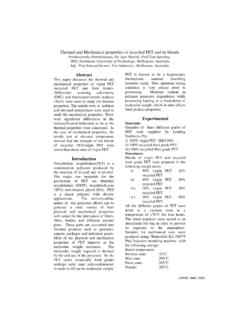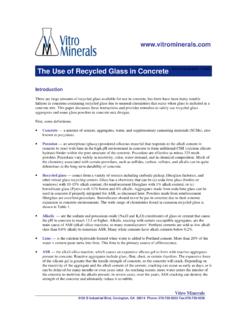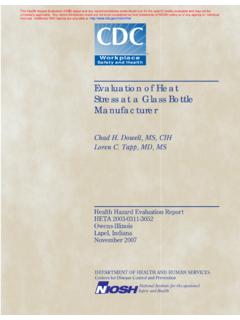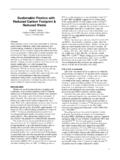Transcription of Thermoforming & Die Cutting of PET Sheet shrunk9-29-02 .d.
1 Thermoforming & Die Cutting of recycled /Virgin PET Sheet (PETCO of Lavergne Group) - 1 - Thermoforming & Die Cutting of recycled /Virgin PET Sheet by Larry Koester, Sheila Nemeth, & Mark Koester of Lavergne Group Contents Section Page(s) Introduction 2-3 What is PET Sheet ? 3-6 Intro: PET in relation to other resins 3-4 PET vs. PVC 4-5 PET Sheet Properties 5-6 Extruding PET Sheet 6 Thermoforming PET Sheet 7-9 Heating PET Sheet 7-8 Forming PET Sheet 8 General Do s and Don ts of Thermoforming PET Sheet 9 Die Cutting PET Sheet 10-14 Kiss Cut Dies (Steel Rule and Forged Dies) 10-11 Scissor-type Dies (Matched Metal Dies) 12-13 General Do s and Don ts of Die Cutting PET Sheet 14 Conclusions 14-16 Summary Checklist 15-16 Appendixes 17-27 I.
2 Glossary 17-20 II. Transition Temperatures of Thermoformable Polymers 20 IIIA. 2000 Gross Recycling Rate 20 IIIB. RPET End Use Products 2000 21 IV. Plastic Bottles by Resin Type 21 V. Comparison of Thermal Conductivity and Thermal Diffusivity for Several Polymer and Mold Materials 22 VI. Shrinkage Values 22 VII. Inflation Pressure Ranges 22 VIII. Drying Conditions 23 IX. Coefficients of Thermal Expansion for Thermoformable Polymers 23 X. Make-Ready Procedure for Kiss Cut Dies 24 XI.
3 Physical Properties of Film Extruded of PETG and APET 25 XII. Technical Data and Property Comparison: RPET vs. PVC 26 XIII. Rockwell Hardness Scale of Abbreviations 26 XIV. Application Pictures 27 Sources, Thanks and Contact Information 28 Lavergne Group Inc. 8800, 1er Croissant, Ville d Anjou, Quebec, Canada H1J 1C8 Thermoforming & Die Cutting of recycled /Virgin PET Sheet (PETCO of Lavergne Group) - 2 - ~ Introduction ~ Over the years, a steady increase in the use of PET has triggered a decrease in the use of aluminum, glass, and other conventional packaging materials.
4 Convenience stores are now stocked with chilled rows of PET bottles of soda, water, milk, and juice, and finding a glass bottle has become a rarity. Even beer bottles have seen a recent shift to plastic at sporting events. The upward trend and usage of PET bottles has trickled down to increased use of PET in other applications including thermoformed PET Sheet . Local groceries and hardware stores are a gallery to the multiple uses of PET Sheet from fruit containers to plastic trays to nut and bolt packages. With this perspective in mind, it is crucial to evaluate the current uses, techniques, properties, and characteristics in Thermoforming and die Cutting recycled and virgin PET Sheet .
5 When a polymer is heated from a low temperature, it transforms from a glassy state to a rubbery state. The temperature in which this transition occurs is generally termed glass transition temperature (abbreviated Tg), and the temperature range over which the polymer is sufficiently pliable for stretching and shaping to a desirable shape is called Thermoforming window. Thermoforming is the general category of processes heating a polymer Sheet to this rubbery state and then using one of several methods to shape the heated Sheet into the desired form.
6 After cooling and hardening, the edges are cut away through a procedure called die Cutting leaving the completed product. While the process may seem simple, numerous factors dictate and manipulate the slim degree of perfection needed to create a perfect product. Not only must the physical properties of the cooled substance be considered, but the properties of the polymer when it is heated must also be calculated. Polyethylene terephthalate or more commonly PET is a polymer made by combining either terephthalic acid or dimethyl terephthalate acid with ethylene glycol.
7 From this chemical combination, a vast range of thermoplastic applications and uses arise for PET and its additive offshoots. PET is an extremely versatile substance, because its properties and characteristics provide relatively easy usability and versatility. Virgin PET Sheet s compliance with Food and Drug Administration (FDA) regulations has allowed a diversity of food applications including such packaging staples as clamshells, trays, containers, and fruit and vegetable baskets. And recycled PET (RPET) through regrind and addition with virgin has allowed companies to create their needed product along with allaying many environmental concerns of tomorrow.
8 The industry has coined several acronyms to specify PET s specific end use capabilities. For example, when used in the crystalline state for ovenable trays, PET is referred to as CPET; when used as oriented film to utilize its toughness, high-temperature and chemical resistance properties, it is termed OPET; when used for the extrusion blow-molding of containers, it is called EPET; and when glycol modifiers are added to minimize brittleness and premature aging, it is called PETG. The acronym APET describes PET when it is in the form of clear, amorphous Sheet for thermoformed packaging and related products.
9 And RPET signifies recycled PET Sheet , which displays similar properties as virgin PET or APET. PETE is utilized on the bottoms of bottles because of copyright infringement of PET Carnation Milk products. For all intense and purposes, APET, PET, RPET, Polyester and PETE are the same thing, polyethylene terephthalate. Thermoforming & Die Cutting of recycled /Virgin PET Sheet (PETCO of Lavergne Group) - 3 - Thermoforming is heating the Sheet , to a temperature below its melting point, to a glassy or soft state, and then stretching it to contours of a mold.
10 The characteristics of PET Sheet are similar to other amorphous Sheet , and thus the Thermoforming methods are comparable as well, especially with PVC. The key considerations to remember with PET Sheet are to keep it very dry and to not overheat; otherwise significant changes occur in the PET weakening its properties. PET is a tough substance, which leads to the biggest challenge facing thermoformers: die Cutting . Although other substances break after only Cutting part way through, PET Sheet has to be cut completely through for it to fracture.








